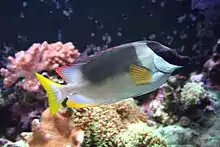Magnificent rabbitfish
The magnificent rabbitfish (Siganus magnificus) is a rabbitfish from the eastern Indian Ocean. It occasionally makes its way into the aquarium trade. It grows to a length of 24 cm.
| Magnificent rabbitfish | |
|---|---|
 | |
| Scientific classification | |
| Kingdom: | Animalia |
| Phylum: | Chordata |
| Class: | Actinopterygii |
| Order: | Perciformes |
| Family: | Siganidae |
| Genus: | Siganus |
| Species: | S. magnificus |
| Binomial name | |
| Siganus magnificus (Burgess, 1977) | |
Description
The magnificent rabbitfish's name is a reference to its rabbit-like facial features. Its face features black coloring and interlocking jaw. S. magnificus has a flat oval body and is one of the most colorful fish in the genus. Organisms grow to lengths of 24 centimeters. In addition it has a long tubular snout used to obtain food from the bottom of reefs. As well as 13 dorsal spines, 10 soft rays, 7 anal spines, 9 anal soft rays and 23 vertebrae.[1]
Range and distribution
S. magnificus is endemic to the Andaman Sea. The species lives in the Indo-pacific region of the world. The species is only found in reef communities around the Simalian Islands, to as far as Java, Indonesia. The species is tropical,ranging from 15 degrees to 0 degrees latitude. It is usually found at a depth between 2 m- 30m. They live in water temperatures between 24 degrees Celsius and 28 degrees Celsius.[2]
Behavior
Signus magnificus is oftentimes found in pairs or found alone. This makes them particularly difficult to find and study. Adults often occur in pair, but juveniles occur alone and hide around and under corals. Although they are not as venomous as other species of Rabbit Fish they are slightly venomous. When this species becomes startled they change to a pale gray color in order to camouflage themselves.[3] Signus magnificus is usually non-aggressive, however when put together in a tank with members of the same species, the fish can become aggressive.
Diet
S. magnificus feeds on small algae and other plant material. Its preferred place to feed is the harder bottoms of coral reefs. It is suggested that it developed the long tubular nose for this reason. Although S. magnificus has a preferred food source of algae, it also feeds off of small invertebrates.
Biodiversity
A survey was taken of the genus Siganidae before the coral bleaching in 2010 and was abundant. Although S. magnificus is not a species of concern,[4] it was noted that after the coral bleaching, the number of S. magnificus in southwestern Thailand decreased.[5]
References
- "Siganus magnificus summary page". FishBase. Retrieved 2019-04-01.
- Lemer, Sarah; Aurelle, Didier; Vigliola, Laurent; Durand, Jean-Dominique; Borsa, Philippe (2007). "Cytochrome b barcoding, molecular systematics and geographic differentiation in rabbitfishes (Siganidae)" (PDF). Comptes Rendus Biologies. 330 (1): 86–94. doi:10.1016/j.crvi.2006.09.002. ISSN 1631-0691. PMID 17241952.
- Woodland, David J.; Randall, John E. (1979-08-01). "Siganus puelloides, a New Species of Rabbitfish from the Indian Ocean". Copeia. 1979 (3): 390. doi:10.2307/1443212. ISSN 0045-8511. JSTOR 1443212.
- "Siganus magnificus: Allen, G.R.". 2009-02-04. doi:10.2305/iucn.uk.2010-4.rlts.t154703a4610996.en. Cite journal requires
|journal=(help) - Sakai, Katsushi (2015). "Upogebiidae Borradaile, 1903 from the Andaman Sea, collected by the Phuket Marine Biological Center, Thailand, with seven new species, presented in revised keys (Thalassinidea Latreille, 1831)". Crustaceana. 88 (5): 577–609. doi:10.1163/15685403-00003425. ISSN 0011-216X.
- Froese, Rainer and Pauly, Daniel, eds. (2008). "Siganus magnificus" in FishBase. December 2008 version.
| Wikimedia Commons has media related to Siganus magnificus. |
